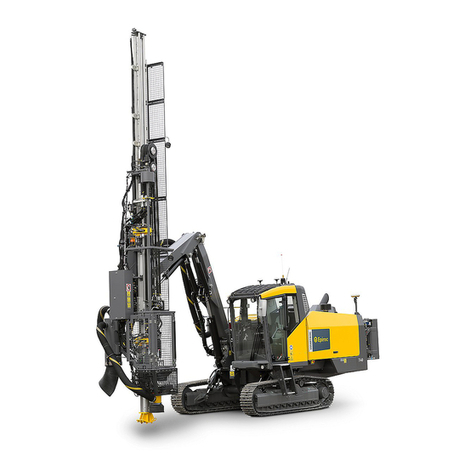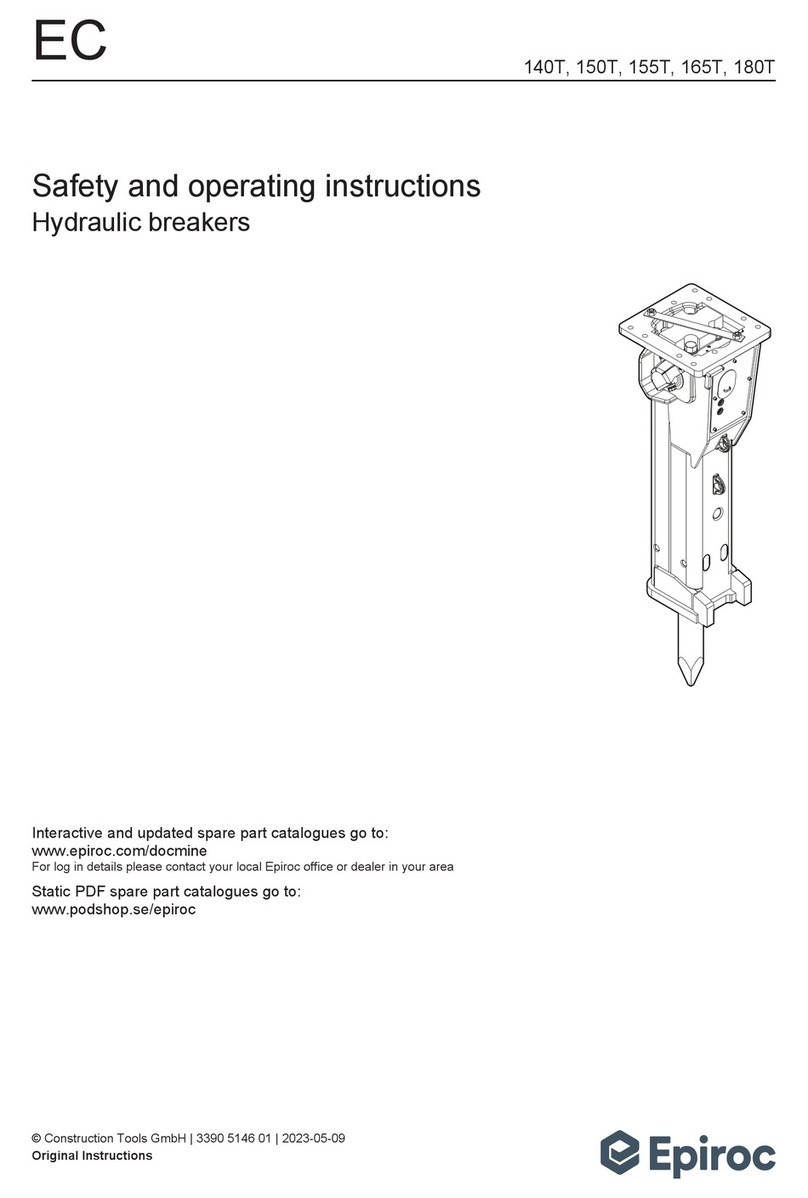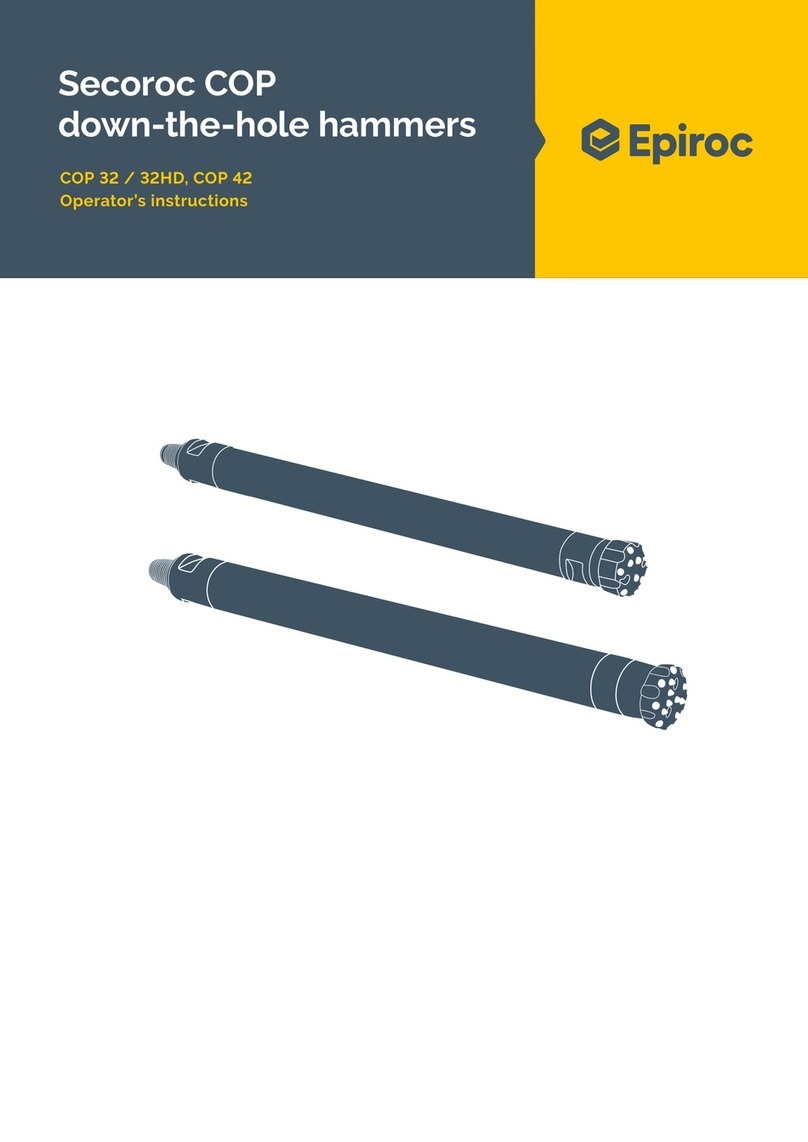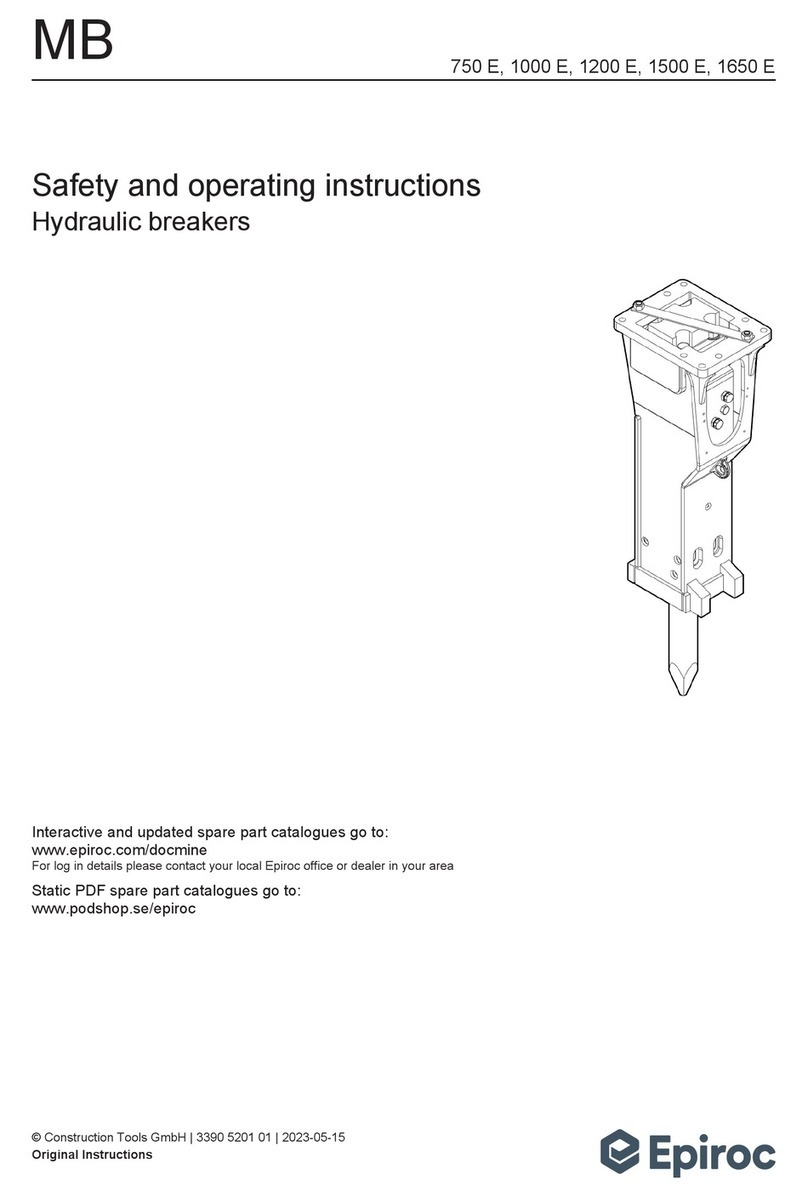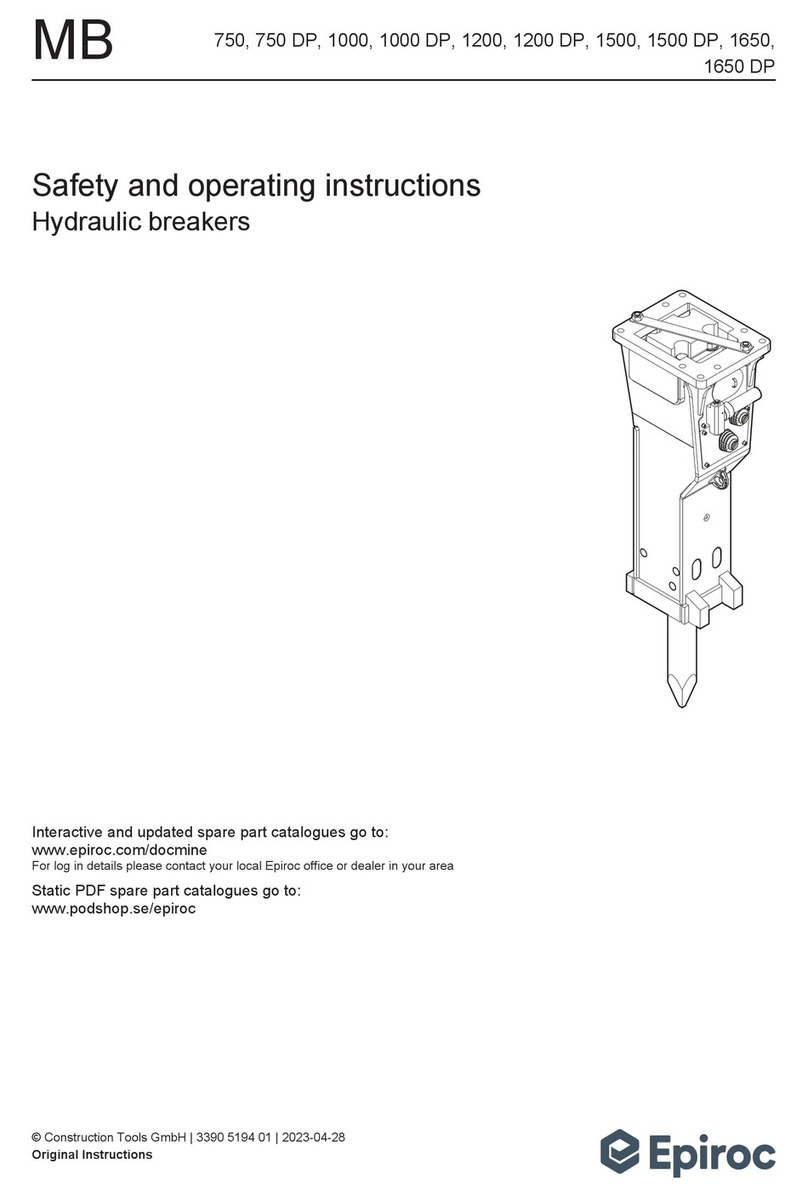Epiroc 70 Maintenance and service guide

PL 70, 70 RB, 100, 100 RB, 120, 120 RB, 150, 150 RB
Safety and operating instructions
Pusher legs
© Construction Tools PC AB | 98001368 01 | 2021-04-06
Original Instructions
Interactive and updated spare part catalogues go to:
www.epiroc.com/docmine
For log in details please contact your local Epiroc office or dealer in your area
Static PDF spare part catalogues go to:
www.podshop.se/epiroc


Contents
© Construction Tools PC AB | 98001368 01 | 2021-04-06
Original Instructions
3
Table of Contents
1 Introduction ................................................................................................................................6
2 About the Safety and operating instructions ..........................................................................6
3 Safety instructions.....................................................................................................................6
3.1 Safety signal words ............................................................................................................................................6
3.2 Personal precautions and qualifications ..........................................................................................................6
3.2.1 Personal protective equipment ..........................................................................................................................6
3.2.2 Drugs, alcohol or medication .............................................................................................................................6
3.3 Installation, precautions.....................................................................................................................................7
3.4 Operation, precautions.......................................................................................................................................7
4 Overview .....................................................................................................................................8
4.1 Design and function............................................................................................................................................8
4.2 Main parts ............................................................................................................................................................9
4.3 Labels...................................................................................................................................................................9
4.3.1 Data plate ..........................................................................................................................................................9
4.3.2 Safety label........................................................................................................................................................9
4.3.3 Pinch point hazard...........................................................................................................................................10
4.4 Guarantee .........................................................................................................................................................10
5 Transport ..................................................................................................................................10
5.1 Lifting the pusher leg .......................................................................................................................................10
6 Installation ................................................................................................................................11
6.1 Adjustment of handle .......................................................................................................................................11
6.2 Attaching pusher leg to rock drill....................................................................................................................11
6.3 Water pressure ..................................................................................................................................................12
7 Operation ..................................................................................................................................12
7.1 Preparations before starting ............................................................................................................................12
7.1.1 Check the drilling equipment ...........................................................................................................................12
7.2 Start and stop ....................................................................................................................................................12
7.2.1 Starting the rock drill (RD 100) ........................................................................................................................12
7.2.2 Starting the rock drill (RD 100 RB) ..................................................................................................................13
7.2.3 Stopping the rock drill (RD 100) ......................................................................................................................13
7.2.4 Stopping the rock drill (RD 100 RB) ................................................................................................................13
7.3 Operating ...........................................................................................................................................................13
7.3.1 Drilling..............................................................................................................................................................13
7.3.2 Re-position of the pusher leg (RD 100) ...........................................................................................................14
7.3.3 Re-position of the pusher leg (RD 100 RB) .....................................................................................................14
7.4 When taking a break .........................................................................................................................................14
7.5 Detaching pusher leg from rock drill ..............................................................................................................15
8 Maintenance .............................................................................................................................15
8.1 Every day ...........................................................................................................................................................15
8.2 Checking for wear .............................................................................................................................................15
8.3 3 times per year.................................................................................................................................................15
8.4 Differences between original parts and pattern parts ...................................................................................15

Contents
4 © Construction Tools PC AB | 98001368 01 | 2021-04-06
Original Instructions
9 Storage......................................................................................................................................16
10 Disposal ....................................................................................................................................16
11 Troubleshooting.......................................................................................................................17
12 Technical data ..........................................................................................................................17
12.1 Machine data .....................................................................................................................................................17
13 EC Declaration of Conformity .................................................................................................18
13.1 EC Declaration of Conformity (EC Directive 2006/42/EC) .............................................................................18

Contents
© Construction Tools PC AB | 98001368 01 | 2021-04-06
Original Instructions
5

Safety and operating instructions
6 © Construction Tools PC AB | 98001368 01 | 2021-04-06
Original Instructions
1 Introduction
Epiroc is a leading productivity partner for the mining, in-
frastructure and natural resources industries. With cut-
ting-edge technology, Epiroc develops and produces in-
novative drill rigs, rock excavation and construction
equipment, and provides world-class service and con-
sumables.
The company was founded in Stockholm, Sweden, and
has passionate people supporting and collaborating with
customers in more than 150 countries.
Construction Tools PC AB
Box 703
391 27 Kalmar
Sweden
2 About the Safety and
operating instructions
The aim of the instructions is to provide you with knowl-
edge of how to use the pusher leg in an efficient, safe
way. The instructions also give you advice and tell you
how to perform regular maintenance on the pusher leg.
Before using the pusher leg for the first time you must
read these instructions carefully and understand all of
them.
3 Safety instructions
To reduce the risk of serious injury or death to yourself
or others, read and understand the Safety and operating
instruction before installing, operating, repairing, main-
taining, or changing accessories on the machine.
Post this Safety and operating instruction at work loca-
tions, provide copies to employees, and make sure that
everyone reads the Safety and operating instruction be-
fore operating or servicing the machine. For professional
use only.
In addition, the operator or the operator's employer must
assess the specific risks that may be present as a result
of each use of the machine.
The pusher leg is used together with a rock drill and a
power pack. Carefully study the safety instructions for
the rock drill and power pack to ensure safe operation.
3.1 Safety signal words
The safety signal words Danger, Warning and Caution
have the following meanings:
DANGER Indicates a hazardous situation
which, if not avoided, will result in
death or serious injury.
WARNING Indicates a hazardous situation
which, if not avoided, could result in
death or serious injury.
CAUTION Indicates a hazardous situation
which, if not avoided, could result in
minor or moderate injury.
3.2 Personal precautions and
qualifications
Only qualified and trained persons may operate or main-
tain the machine. They must be physically able to handle
the bulk, weight, and power of the tool. Always use your
common sense and good judgement.
3.2.1 Personal protective equipment
Always use approved protective equipment. Operators
and all other persons in the working area must wear pro-
tective equipment, including at a minimum:
• Protective helmet
• Hearing protection
• Impact resistant eye protection with side protection
• Respiratory protection when appropriate
• Protective gloves
• Proper protective boots
• Appropriate work overall or similar clothing (not
loose-fitting) that covers your arms and legs.
3.2.2 Drugs, alcohol or medication
WARNING Drugs, alcohol or medication
Drugs, alcohol or medication may impair your judgment
and powers of concentration. Poor reactions and incor-
rect assessments can lead to severe accidents or death.
uNever use the machine when you are tired or under
the influence of drugs, alcohol or medication.
uNo person who is under the influence of drugs, alco-
hol or medication may operate the machine.

Safety and operating instructions
© Construction Tools PC AB | 98001368 01 | 2021-04-06
Original Instructions
7
3.3 Installation, precautions
WARNING Whipping hose
Hoses under pressure can whip uncontrollably if screws
loosen or are loosened. A whipping hose can cause se-
vere injuries. To reduce this risk:
uDepressurise the system before loosening the con-
nection of a hose.
uTighten the nuts on the connections of the hoses to
required torque.
uCheck that the hose and the connections are not
damaged.
uNever carry the machine by the hoses.
WARNING Injured hands
There is a risk of injured fingers when mounting the
pusher leg on the rock drill. To recuce this risk:
uNever inspect, clean, install, or remove the pusher
leg while the power source is connected.
uNever put the fingers between the rock drill and
pusher leg attachment.
3.4 Operation, precautions
DANGER Electrical hazard
The machine is not electrically insulated. If the machine
comes into contact with electricity, serious injuries or
death may result.
uNever operate the machine near any electric wire or
other source of electricity.
uMake sure that there are no concealed wires or other
sources of electricity in the working area.
WARNING Unexpected movements
The equipment is exposed to heavy strains when the
machine is used. The inserted tool may break due to fa-
tigue after a certain amount of use. If the inserted tool
breaks or gets stuck, there may be sudden and unex-
pected movement that can cause injuries. Furthermore,
losing your balance or slipping may cause injury.
uMake sure that you always keep a stable position
with your feet as far apart as your shoulder width,
and keeping a balanced body weight.
uAlways inspect the equipment prior to use. Never
use the equipment if you suspect that it is damaged.
uMake sure that the handles are clean and free of
grease and oil.
uStand firmly and always hold on to the rock drill with
both hands.
uNever operate the machine when it is lying on the
ground.
uNever strike or abuse the equipment.
uCheck regularly for wear on the equipment, and
check whether there are any signs of damage or visi-
ble cracks.
uPay attention and look at what you are doing.
uNever rest on the pusher leg.
uTo ensure a stable position, press the foot on the
pusher leg.
WARNING Abuse hazard
Never abuse or strike the pusher leg. This may cause
machine breakdown.
uPress the pusher leg foot. Do not press the pusher
leg body.
uStore the pusher leg compressed.
WARNING Slipping, tripping and falling hazards
There is a risk of slipping, tripping or falling, for example
tripping on hoses or on other objects. Slipping, tripping
or falling can cause injury. To reduce this risk:
uAlways make sure that no hose or other object is in
your way or in any other person's way.
uAlways make sure you are in a stable position with
your feet as far apart as your shoulder width and
keeping a balanced body weight.
WARNING Motion hazards
When using the machine to perform work-related activi-
ties, you may experience discomfort in the hands, arms,
shoulders, neck, or other parts of the body.
uAdopt a comfortable posture while maintaining se-
cure footing and avoiding awkward off-balanced pos-
tures.
uChanging posture during extended tasks may help
avoid discomfort and fatigue.
uIn case of persistent or recurring symptoms, consult
a qualified health professional.
WARNING Vibration hazards
Normal and proper use of the machine exposes the op-
erator to vibration. Regular and frequent exposure to vi-
bration may cause, contribute to, or aggravate injury or
disorders to the operator’s fingers, hands, wrists, arms,
shoulders and/or nerves and blood supply or other body
parts, including debilitating and/or permanent injuries or
disorders that may develop gradually over periods of
weeks, months, or years. Such injuries or disorders may
include damage to the blood circulatory system, damage
to the nervous system, damage to joints, and possibly
damage to other body structures.
If numbness, persistent recurring discomfort, burning
sensation, stiffness, throbbing, tingling, pain, clumsiness,
weakened grip, whitening of the skin, or other symptoms

Safety and operating instructions
8 © Construction Tools PC AB | 98001368 01 | 2021-04-06
Original Instructions
occur at any time, when operating the machine or when
not operating the machine, stop operating the machine,
tell your employer and seek medical attention. Continued
use of the machine after the occurrence of any such
symptom may increase the risk of symptoms becoming
more severe and/or permanent.
Operate and maintain the machine as recommended in
these instructions, to prevent an unnecessary increase
in vibration.
The following may help to reduce exposure to vibration
for the operator:
uLet the tool do the job. Use a minimum hand grip
consistent with proper control and safe operation.
uIf the machine has vibration absorbing handles, keep
them in a central position, avoid pressing the handles
into the end stops.
uWhen the rock drill is activated, the only body contact
with the machine you should have are your hands on
the handle or handles. Avoid any other contact, for
example supporting any part of the body against the
machine or leaning onto the machine trying to in-
crease the feed force. It is also important not to keep
the start and stop device engaged while extracting
the tool from the broken work surface.
uImmediately stop working if the machine suddenly
starts to vibrate strongly. Before resuming the work,
find and remove the cause of the increased vibra-
tions.
uParticipate in health surveillance or monitoring, medi-
cal exams and training programs offered by your em-
ployer and when required by law.
uWhen working in cold conditions wear warm clothing
and keep hands warm and dry.
WARNING Machine modification
Any machine modification may result in bodily injuries to
yourself or others.
uNever modify the machine. Modified machines are
not covered by warranty or product liability.
uAlways use approved original parts, tools, and ac-
cessories.
uChange damaged parts immediately.
uReplace worn components in good time.
WARNING Hot water hazard
The flushing water can become hot and cause burns. To
reduce the risk of burns:
uKeep your body away from the hot water.
uStop the machine and the power source immediately.
uWait until the machine and power source has cooled
down before carrying out maintenance work.
WARNING Choosing power pack
The pusher leg and the handheld hydraulic rock drills are
designed for working together with Epiroc power packs.
Use of other power sources can lead to personal injury
and machine breakdown.
uEnsure that the power source you plan to use is
compatible with the rock drill and the pusher leg, see
section "Technical data".
WARNING Concealed object hazard
During operating, concealed wires and pipes constitute a
danger that can result in serious injury.
uCheck the composition of the material before operat-
ing.
uWatch out for concealed cables and pipes for exam-
ple electricity, telephone, water, gas and sewage
lines etc.
uIf the pusher leg foot seems to have hit a concealed
object, switch off the machine immediately.
uMake sure that there is no danger before continuing.
4 Overview
To reduce the risk of serious injury or death to your-
self or others, read the Safety instructions section
found on the previous pages of this manual before
operating the machine.
4.1 Design and function
PL 70, PL 100, PL 120 and PL 150 are designed to be
used together with power pack of type PP 100, and hy-
draulic rock drill of type RD 100.
PL 70 RB, PL 100 RB, PL 120 RB and PL 150 RB are
designed to be used together with PP 100 and RD 100
RB.
The pusher leg is connected to the rock drill by a special
attachment device and is operated via the rock drill.
The feed movement of the pusher leg is powered by wa-
ter pressure from the power pack via the rock drill. Rec-
ommended water pressure to the power pack is between
5 bar (73 psi) and 7 bar (101.5 psi) at 12 l.p.m (0.42 ft3/
min) flowrate. The pressure regulator in the power pack
is reducing the pressure to a maximum of 8 bar (116
psi).
The pusher leg support is for helping the operator to lift
and feed the rock drill during drilling operations. Retract
the pusher leg by turning the twist handle backwards.
Extract the pusher leg by turning the twist handle for-
ward.

Safety and operating instructions
© Construction Tools PC AB | 98001368 01 | 2021-04-06
Original Instructions
9
No other use is permitted.
4.2 Main parts
A
B
C
A
D
C
B
A. Attachment device
B. Handle
C. Foot
D. Twist handle
4.3 Labels
The machine is fitted with labels containing important in-
formation about personal safety and machine mainte-
nance. The labels must be in such condition that they
are easy to read. New labels can be ordered from the
spare parts list.
4.3.1 Data plate
A
BCDE
F
A. Machine type.
B. Maximum water pressure.
C. Serial number.
D. The warning symbol together with the book symbol
means that the user must read the safety and oper-
ating instructions before the machine is used for the
first time.
E. The CE symbol means that the machine is EC-ap-
proved. See the EC Declaration of Conformity which
is delivered with the machine for more information.
F. The EAC symbol means that the machine is EAC
approved.
4.3.2 Safety label
To avoid injury, before using or servicing tool, read and
understand separately provided safety instructions.

Safety and operating instructions
10 © Construction Tools PC AB | 98001368 01 | 2021-04-06
Original Instructions
4.3.3 Pinch point hazard
WARNING Pinch Point
Accidental drop of Rock drill when operating may result
in hand injury.
uKeep hands clear of the attaching area between
Pusher leg and Rock drill.
uAlways pay attention when operating.
4.4 Guarantee
The guarantee or product liability will be invalidated by
the following:
• Use other than intended
• Maintenance work not being carried out or being
carried out incorrectly
• The use of the wrong consumables
• The use of non-approved parts
• Damage due to wear
• Special applications without the required safety facil-
ities
• Damage due to improper storage
• Changes not carried out by or in consultation with
the manufacturer
5 Transport
Ensure that the pusher leg is compressed and secured
during transportation.
Drain the water system if there is risk of freezing. See
"Detaching pusher leg from rock drill".
5.1 Lifting the pusher leg
Grab the handle on the pusher leg, see illustration be-
low. Lift the pusher leg and move it to its intended desti-
nation.

Safety and operating instructions
© Construction Tools PC AB | 98001368 01 | 2021-04-06
Original Instructions
11
6 Installation
WARNING Injured hands
There is a risk of injured fingers when mounting the
pusher leg on the rock drill. To recuce this risk:
uNever inspect, clean, install, or remove the pusher
leg while the power source is connected.
uNever put the fingers between the rock drill and
pusher leg attachment.
6.1 Adjustment of handle
Move the handle to the position wanted.
6.2 Attaching pusher leg to rock
drill
A
B
A
B
1. Make sure that the pin (A) and the machine attach-
ment are clean.
2. Pull out the locking lever (B) and turn counterclock-
wise to lock it in the open position.
3. Mount the pusher leg to the rock drill.
4. Turn the locking lever (B) clockwise to secure the
pusher leg. Make sure that the lever gets pushed all
the way in.
5. Fill the pusher leg with water by turning forward/back-
ward the twist handle of rock drill to extract and re-
tract the pusher leg 2-3 times.

Safety and operating instructions
12 © Construction Tools PC AB | 98001368 01 | 2021-04-06
Original Instructions
6.3 Water pressure
Ensure that the water supply to the power pack meets
the requirements of incoming pressure between 5-7 bar
(73-101.5 psi).
• Too high pressure causes rough operation and ex-
cessive wear.
• Too low pressure results in irregular and slow drilling
speed and might damage the RD 100.
7 Operation
WARNING Involuntary start
Involuntary start of the machine may cause injury.
uKeep your hands away from the start and stop de-
vice until you are ready to start the machine.
uLearn how the machine is switched off in the event of
an emergency.
uStop the machine immediately in all cases of power
supply interruption.
CAUTION Idling strokes
Prolonged idling strokes can cause damage on percus-
sion unit of the rock drill.
uStop the rock drill immediately after the drilling is
done.
7.1 Preparations before starting
WARNING Whipping hose
Hoses under pressure can whip uncontrollably if screws
loosen or are loosened. A whipping hose can cause se-
vere injuries. To reduce this risk:
uDepressurise the system before loosening the con-
nection of a hose.
uTighten the nuts on the connections of the hoses to
required torque.
uCheck that the hose and the connections are not
damaged.
uNever carry the machine by the hoses.
7.1.1 Check the drilling equipment
nCheck that all of the drilling equipment is in good con-
dition.
nCheck that the impact surface of the drill steel shank
is flat, with no signs of wear.
nCheck that the flushing holes in the drill steel and drill
bit are not blocked, and that the water flows through
without obstruction.
nEnsure that the fittings are tight and leak-proof.
nEnsure that the twist handle is in the neutral position
to avoid involuntary extract or retract of the pusher
leg during start.
nEnsure that the throttle lever is in the stop position.
7.2 Start and stop
7.2.1 Starting the rock drill (RD 100)
B
AC
1. Check that the drill steel and drill bit are in good con-
dition and properly attached to the rock drill.
2. Check that the tool retainer is locked, so that the drill
steel does not fall out.
3. Start the power source.
4. Adjust the twist handle (A) to give a suitable feed
force for collaring the hole.
5. Align the rock drill so that the drill steel touches the
required collaring point. Avoid small irregularities on
the surface, since they break easily and cause either
a wrong working angle or blank firing.
6. Move the throttle lever (B) forward a little, which
starts the water flushing, the percussion and rotation.
7. Press the rock drill firmly against the material to be
drilled. Turn the twist handle to push the rock drill for-
ward by means of the pusher leg. Increase to full
throttle when collaring is under control.

Safety and operating instructions
© Construction Tools PC AB | 98001368 01 | 2021-04-06
Original Instructions
13
8. Adjust the feed force to ensure that the rock drill runs
regularly.
7.2.2 Starting the rock drill (RD 100 RB)
B
A
1. Check that the drill steel and drill bit are in good con-
dition and properly attached to the rock drill.
2. Check that the tool retainer is locked, so that the drill
steel does not fall out.
3. Start the power source.
4. Adjust the twist handle (A) to give a suitable feed
force for collaring the hole. Turn the twist handle (A)
forward to extract the pusher leg, backward to retract
it.
5. Align the rock drill so that the drill steel touches the
required collaring point. Avoid small irregularities on
the surface, since they break easily and cause either
a wrong working angle or blank firing.
6. Move the trigger (B) forward a little, which starts the
percussion and rotation.
7. Press the rock drill firmly against the material to be
drilled. Turn the twist handle to push the rock drill for-
ward by means of the pusher leg. Increase to full
throttle when collaring is under control.
8. Adjust the feed force to ensure that the rock drill runs
regularly.
7.2.3 Stopping the rock drill (RD 100)
B
AC
nPull the throttle lever (B) backwards. This stops the
percussion, rotation, and flushing water.
7.2.4 Stopping the rock drill (RD 100 RB)
B
A
nPull the trigger (B) backwards. This stops the percus-
sion, rotation and flushing water.
7.3 Operating
7.3.1 Drilling
nUse protective shoes, gloves, helmet, ear protectors
and impact resistant eye protection with side protec-
tion.

Safety and operating instructions
14 © Construction Tools PC AB | 98001368 01 | 2021-04-06
Original Instructions
nStand firmly and always hold the machine with both
hands.
nHold the inserted tool firmly against the work surface
before starting the machine.
nKeep hands away from chuck, drill steel and drill bit.
7.3.2 Re-position of the pusher leg (RD
100)
B
A
B
A
1. Switch off the rock drill percussion, rotation and flush-
ing by means of the throttle lever (B).
2. Retract the pusher leg, by turning the twist handle
(A).
3. Re-position the pusher leg. Ensure that the pusher
leg stands securely on the ground.
4. Follow the start procedures , see section "Starting the
rock drill".
7.3.3 Re-position of the pusher leg (RD 100
RB)
B
A
1. Switch off the rock drill percussion, rotation and flush-
ing by means of the trigger (B).
2. Retract the pusher leg, by turning the twist handle (A)
backward.
3. Re-position the pusher leg. Ensure that the pusher
leg stands securely on the ground.
4. Follow the start procedures , see section "Starting the
rock drill".
7.4 When taking a break
nPlace the machine in such a way that there is no risk
for it to be unintentionally started. Make sure to place
the machine on the ground, so that it can not fall.
nIn the event of a longer break or when leaving the
workplace: Switch off the power source and shut off
the incoming water supply.

Safety and operating instructions
© Construction Tools PC AB | 98001368 01 | 2021-04-06
Original Instructions
15
7.5 Detaching pusher leg from
rock drill
B
A
B
A
C
1. Pull out the locking lever (B) and dismount the pusher
leg from the rock drill.
2. For RD 100, Drain the water by turning the pusher
leg upside down and extract and retract it a few
times.
For RD 100 RB, turn twist handle (C) forward maxi-
mumly to extract the leg fully, and backward maxi-
mumly to retract the leg fully, repeat 1 - 2 times to
drain the water.
8 Maintenance
Regular maintenance is a basic requirement for the con-
tinued safe and efficient use of the machine. Follow the
maintenance instructions carefully.
nBefore starting maintenance on the machine, clean it
in order to avoid exposure to hazardous substances.
nUse only authorised parts. Any damage or malfunc-
tion caused by the use of unauthorised parts is not
covered by warranty or product liability.
nWhen cleaning mechanical parts with solvent, comply
with appropriate health and safety regulations and
ensure there is satisfactory ventilation.
nFor major service of the machine, contact the nearest
authorised workshop.
8.1 Every day
nCheck the rock drill's connection to the pusher leg.
nCheck the hoses, couplings and controls for leakage
and damage.
nCheck the sealing-rings on the attachment device be-
tween the pusher leg and the rock drill.
nClean and inspect the drilling equipment and its func-
tions each day before start working.
8.2 Checking for wear
nCheck the spikes on the pusher leg foot. Replace the
spikes if they show signs of wear.
8.3 3 times per year
nThe machine must be inspected and serviced three
times per year by authorised staff, trained for this
task.
8.4 Differences between original
parts and pattern parts
When buying a part, the first thing to do is to verify that
the part is an Epiroc part. Most parts can be identified.

Safety and operating instructions
16 © Construction Tools PC AB | 98001368 01 | 2021-04-06
Original Instructions
Rock drill parts are normally marked with a part number
and the Epiroc identity mark which is a circle with a rock
drill. In a few cases the part is marked either with the cir-
cle only or the part number only.
Rubber and plastic parts are not normally marked.
9 Storage
nAlways store the pusher leg in a clean and dry place.
Avoid exposure to direct sunlight.
nStore the pusher leg compressed.
nMake sure that no foreign matter enters the pusher
leg.
nDrain the water from the pusher leg if there is risk of
freezing. See "Detaching pusher leg from rock drill".
10 Disposal
A used machine must be treated and disposed of in such
a way that the greatest possible portion of the material
can be recycled and any negative influence on the envi-
ronment is kept as low as possible, and in respect to lo-
cal restrictions.

Safety and operating instructions
© Construction Tools PC AB | 98001368 01 | 2021-04-06
Original Instructions
17
11 Troubleshooting
Problem Cause Solution
Insufficient feed force Low water pressure. Increase water pressure to between 5
bar (73 psi) and 7 bar (101.5 psi).
Piston rod gasket and/or O-ring are
worn or deformed.
Replace the gasket and O-ring.
Leakage. Replace worn sealings.
Impossible to extend or retract the
pusher leg
The pusher leg has been damaged or
bent.
Contact an authorised workshop for
assistance.
The pusher leg is obstructed by dirt
or impurities.
Perform cleaning according to section
"Maintenance".
12 Technical data
12.1 Machine data
Type Suitable for rock
drill
Length retracted
mm (in.)
Stroke
mm (in.)
Weight
kg (lb)
PL 70 RD 100 760 (29.9) 468 (18.4) 8.8 (19.4)
PL 100 RD 100 1060 (41.7) 768 (30.2) 10.5 (23.1)
PL 120 RD 100 1260 (49.6) 968 (38.1) 11.6 (25.6)
PL 150 RD 100 1560 (61.4) 1268 (49.9) 13.4 (29.5)
Type Suitable for rock
drill
Length retracted
mm (in.)
Stroke
mm (in.)
Weight
kg (lb)
PL 70 RB RD 100 851 (33.59) 468 (18.4) 10.4(22.9)
PL 100 RB RD 100 1151 (45.3) 768 (30.2) 12.1 (26.7)
PL 120 RB RD 100 1351 (53.2) 968 (38.1) 13.2 (29.1)
PL 150 RB RD 100 1651 (65.0) 1268 (49.9) 15.0 (33.1)

Safety and operating instructions
18 © Construction Tools PC AB | 98001368 01 | 2021-04-06
Original Instructions
13 EC Declaration of Conformity
13.1 EC Declaration of Conformity (EC Directive 2006/42/EC)
We, Construction Tools PC AB, hereby declare that the machines listed below conform to the provisions of EC Directive
2006/42/EC (Machinery Directive), and the harmonised standards mentioned below.
Pusher leg Pmax (bar) Weight (kg)
PL 70 10 8.8
PL 100 10 10.5
PL 120 10 11.6
PL 150 10 13.4
Pusher leg Pmax (bar) Weight (kg)
PL 70 RB 10 10.4
PL 100 RB 10 12.1
PL 120 RB 10 13.2
PL 150 RB 10 15.0
Following harmonised standard was applied:
nEN ISO 11148-5
Technical Documentation authorised representative:
Olof Östensson
Construction Tools PC AB
Box 703
391 27 Kalmar
General Manager:
Niclas Hejdenberg
Manufacturer:
Construction Tools PC AB
Box 703
391 27 Kalmar
Sweden


epiroc.com
© Construction Tools PC AB | 98001368 01 | 2021-04-06
Any unauthorized use or copying of the contents or any part thereof is prohibited. This
applies in particular to trademarks, model denominations, part numbers, and drawings.
This manual suits for next models
7
Table of contents
Other Epiroc Industrial Equipment manuals
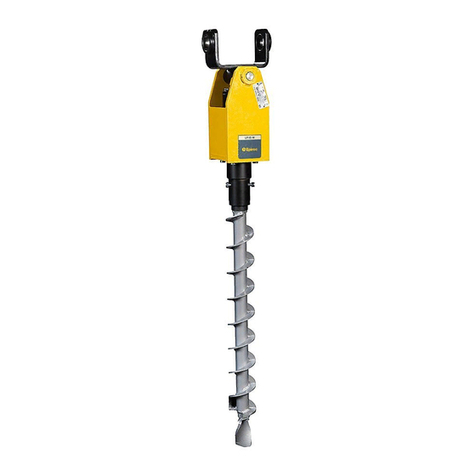
Epiroc
Epiroc LPHB-M Maintenance and service guide
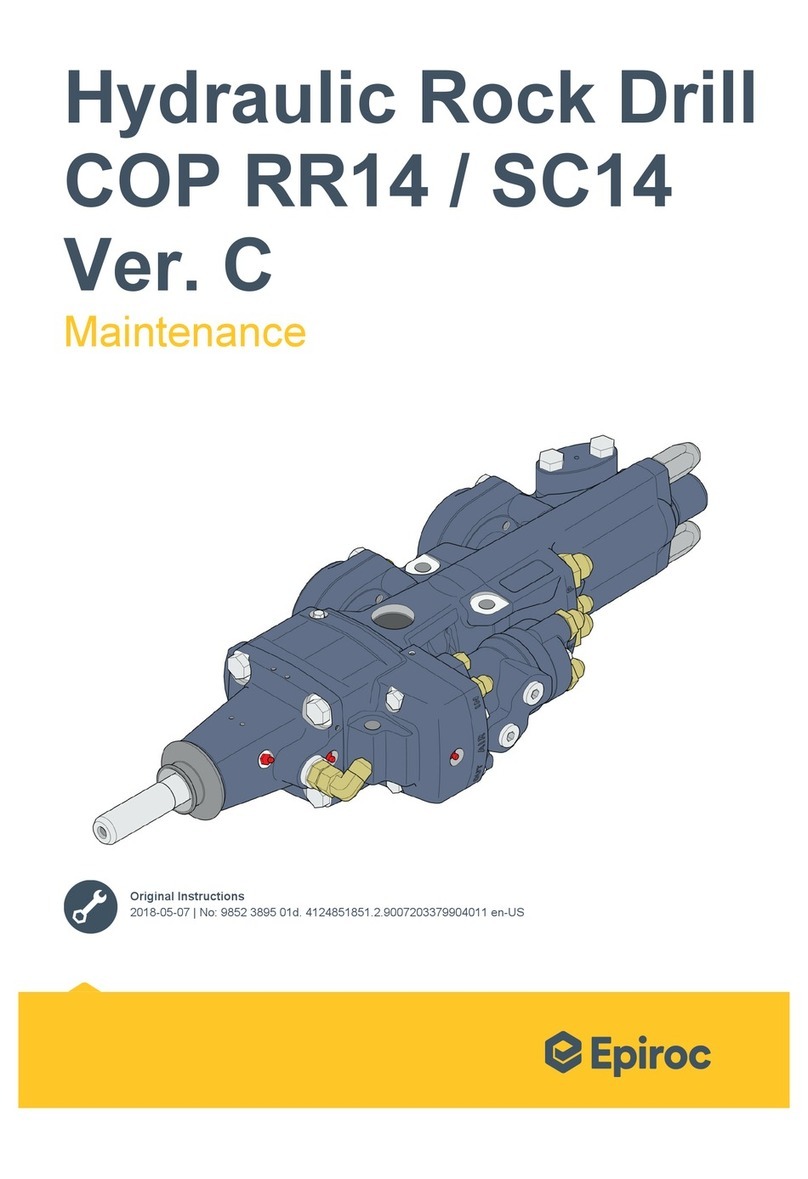
Epiroc
Epiroc COP RR14 Guide
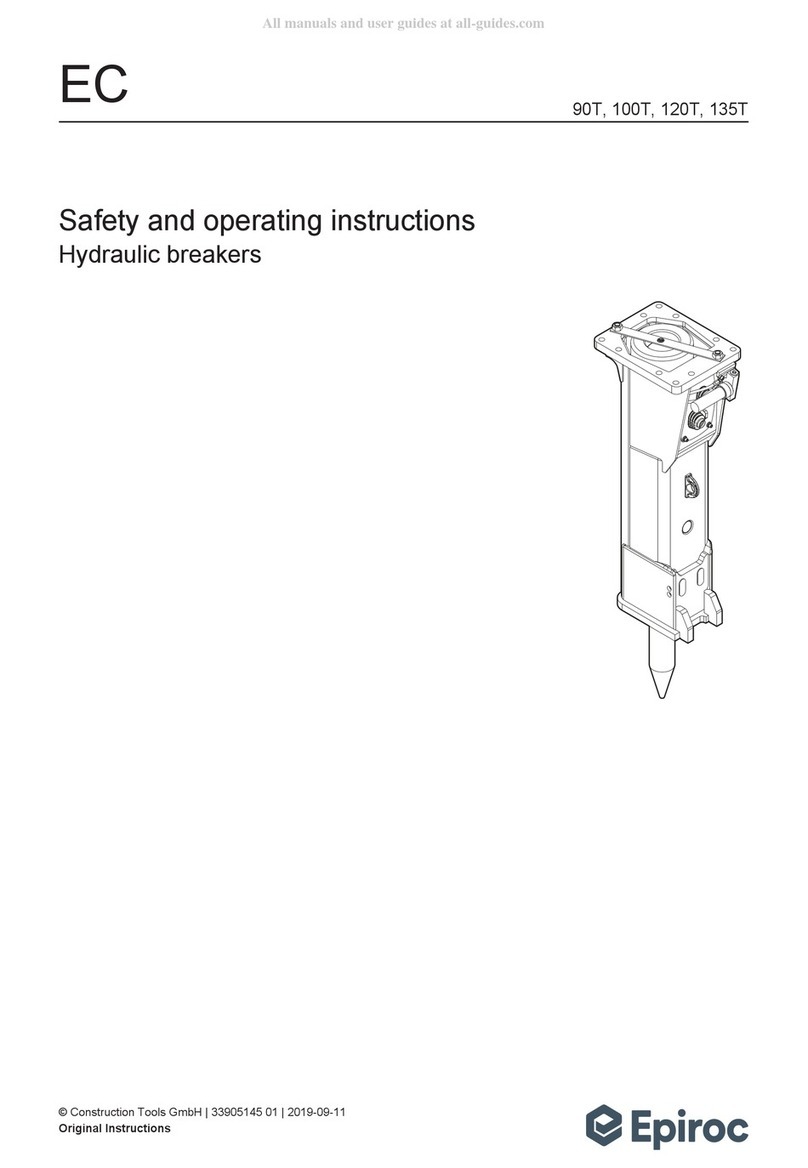
Epiroc
Epiroc 90T Maintenance and service guide
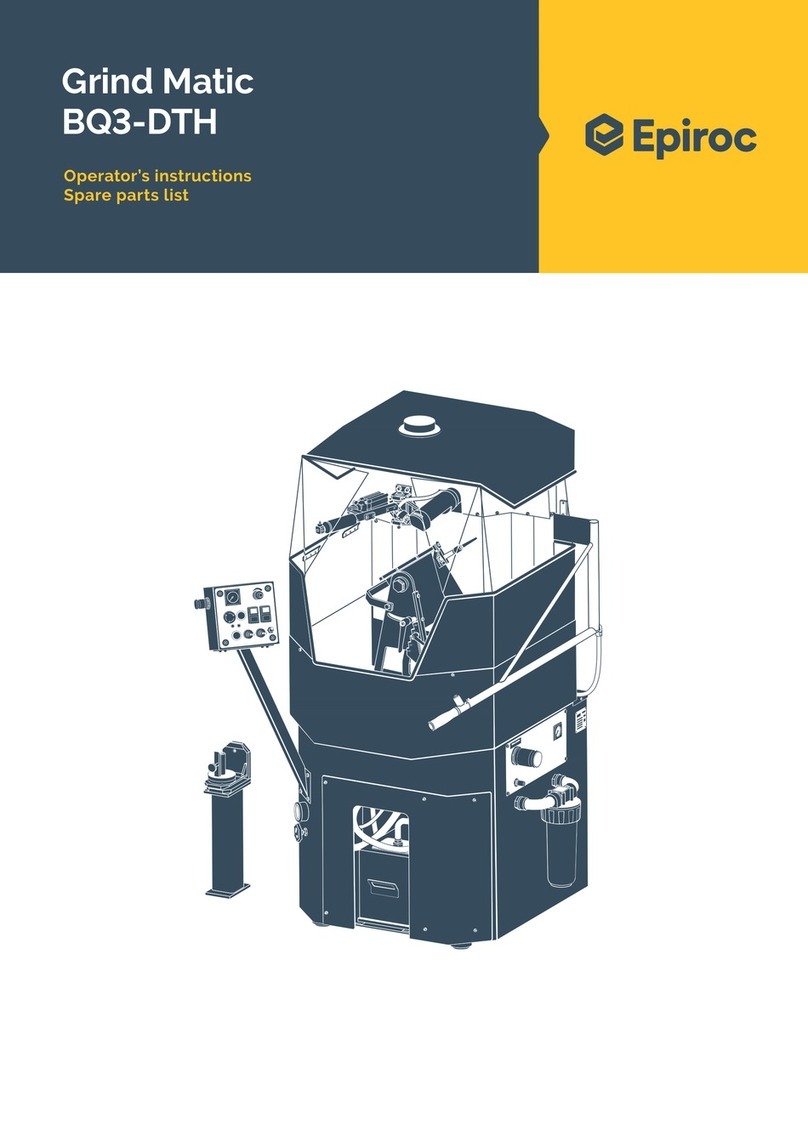
Epiroc
Epiroc BQ3-DTH User manual
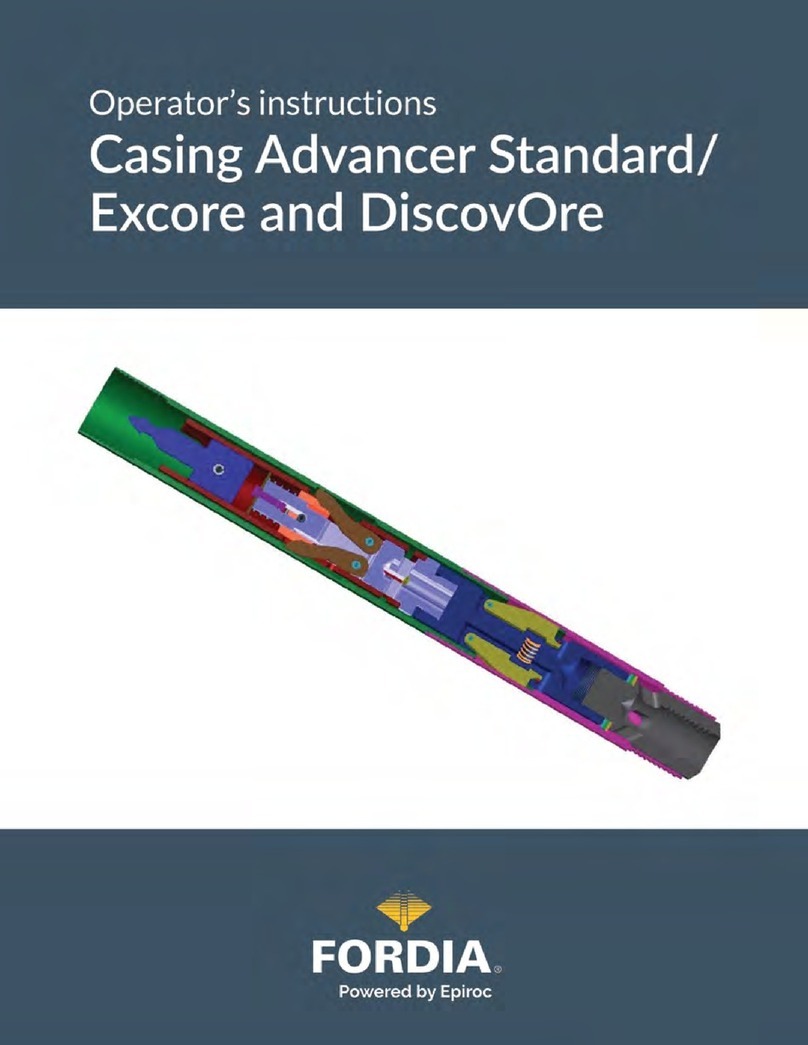
Epiroc
Epiroc FORDIA Casing Advancer Standard User manual
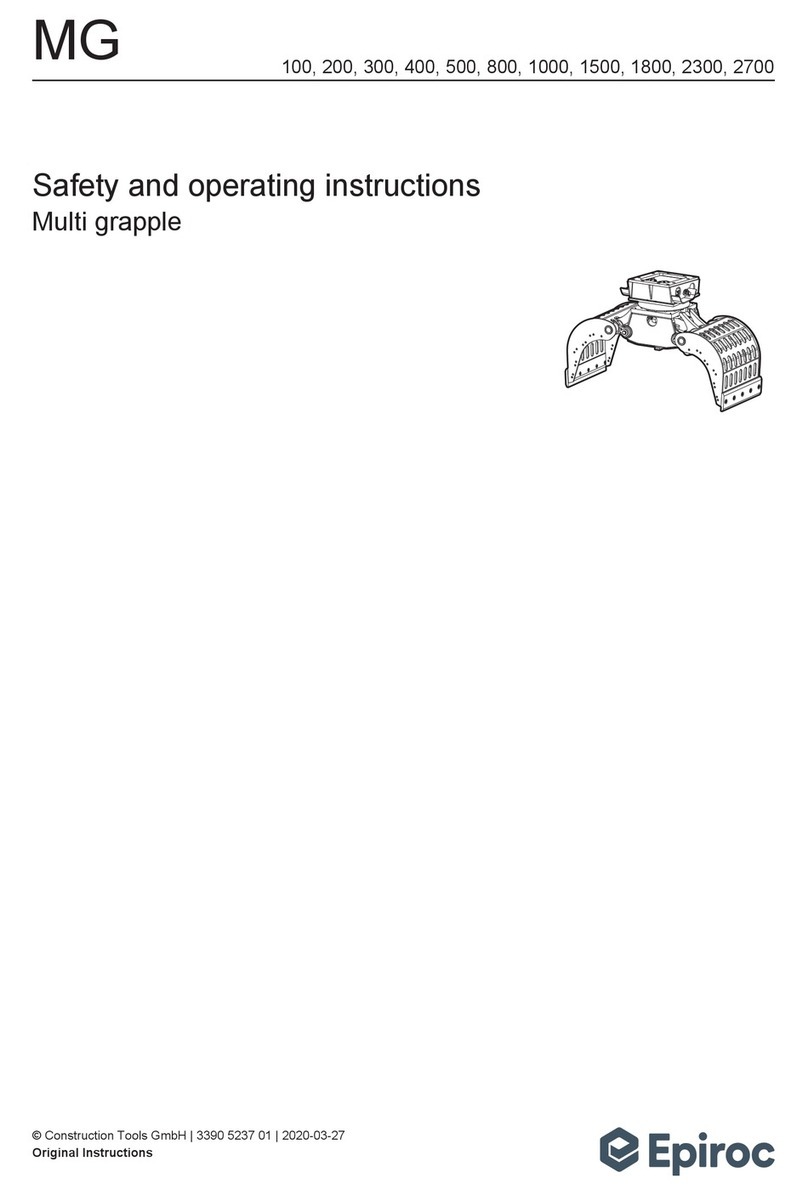
Epiroc
Epiroc MG 100 Maintenance and service guide
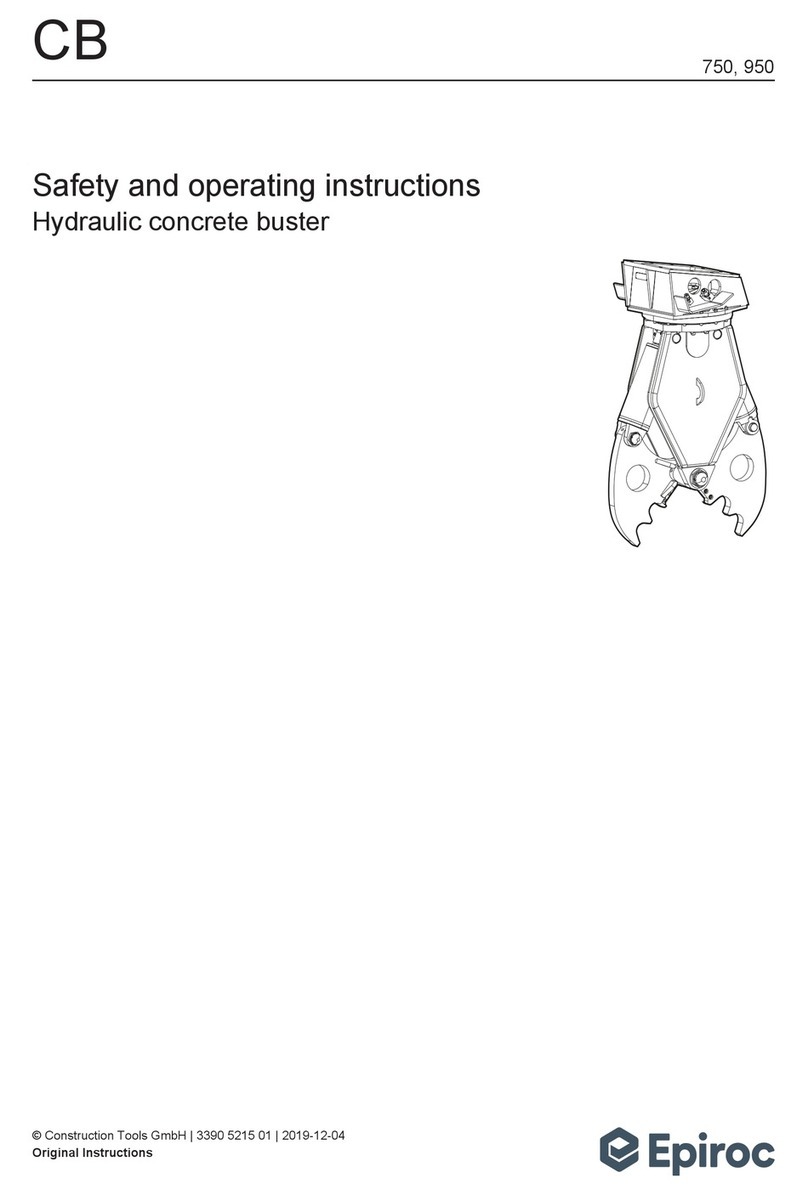
Epiroc
Epiroc CB Series Maintenance and service guide
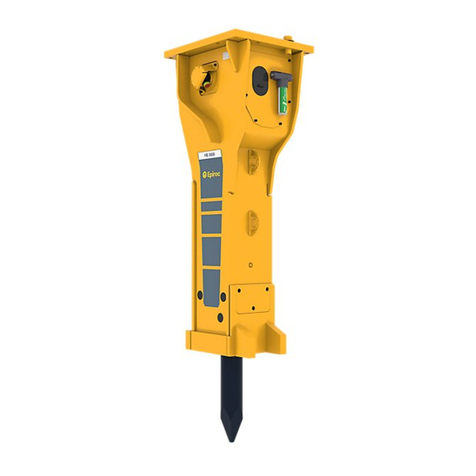
Epiroc
Epiroc HB Series Maintenance and service guide
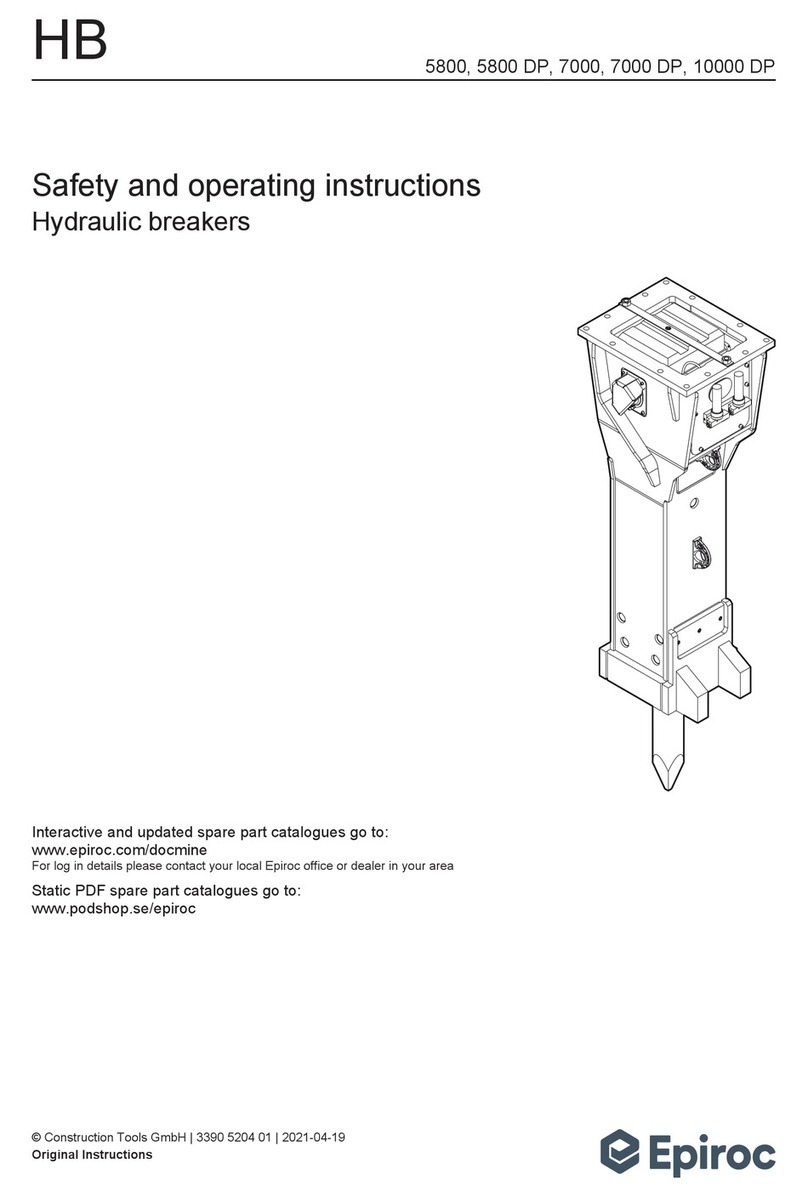
Epiroc
Epiroc HB 5800 Maintenance and service guide
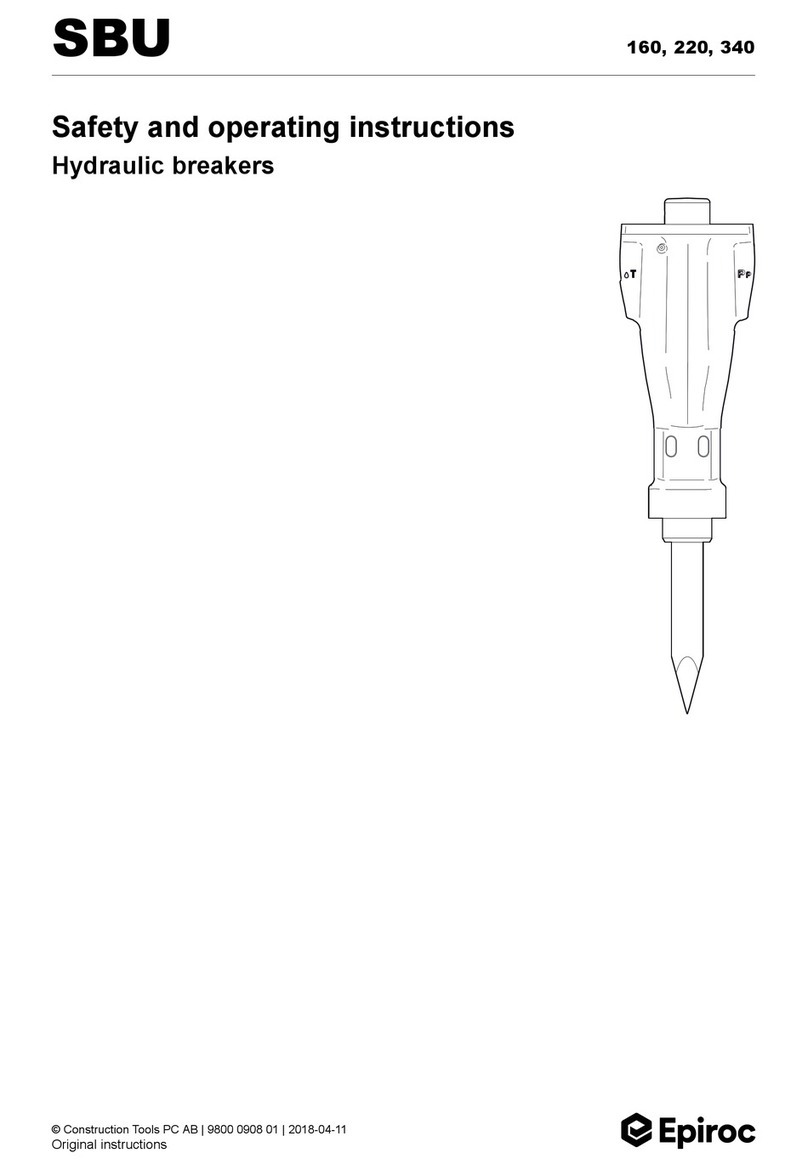
Epiroc
Epiroc SBU 220 Maintenance and service guide
